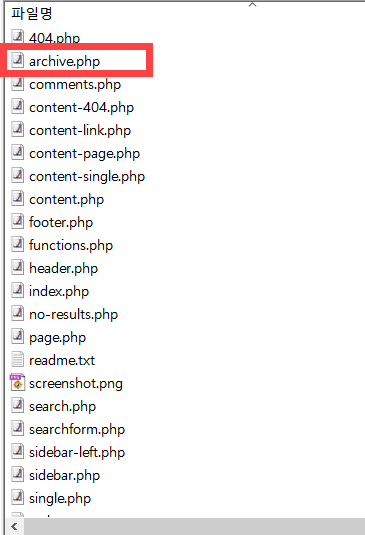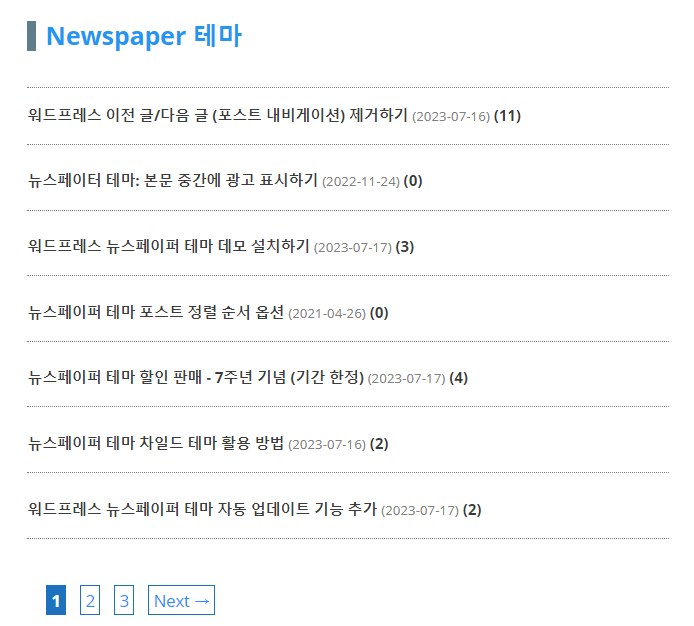워드프레스에서는 테마 파일을 수정하여 특정 카테고리 페이지 또는 태그 페이지의 레이아웃을 다르게 꾸밀 수 있습니다. 최근에는 워드프레스 알림판 내에서 특정 카테고리/태그 템플릿을 만들 수 있도록 발전하고 있습니다. 엘리멘터 프로나 아바다 또는 Divi와 같은 전체 사이트 편집(Full Site Editing) 기능을 제공하는 페이지 빌더나 테마를 이용하면 수월하게 관리자 페이지 내에서 사이트의 모든 섹션을 커스텀할 수 있습니다.
이 블로그에 사용된 GeneratePress 테마의 유료 버전에서도 Elements를 통해 비슷한 기능을 제공합니다. 루프 템플릿을 생성하여 특정 카테고리 페이지나 태그 페이지에 다른 레이아웃을 만들 수 있습니다.
GeneratePress 테마: 카테고리/태그 템플릿 레이아웃 커스터마이징 방법
GeneratePress 테마의 사용자 정의하기에서 아카이브 페이지에 대하여 설정하는 레이아웃이 모든 아카이브 페이지(블로그 페이지, 모든 카테고리 페이지와 태그 페이지 등)에 적용됩니다.
특정 카테고리 페이지나 태그 페이지에 다른 스타일을 적용하고 싶은 경우 루프 템플릿을 생성하여 꾸밀 수 있지만, 이 글에서는 테마 파일을 수정하여 카테고리/태그 페이지 레이아웃을 커스터머마이징하는 방법에 대하여 살펴보겠습니다.
워드프레스 카테고리 템플릿과 태그 템플릿
GP 테마에서 카테고리 템플릿과 태그 템플릿의 레이아웃은 외모 » 사용자 정의하기 » Layout » Blog 섹션에서 지정한 설정으로 표시됩니다.
여기에서 설정한 레이아웃이 블로그 페이지와 카테고리 페이지, 태그 페이지 등 모든 아카이브 페이지에 적용됩니다.
특정 카테고리 페이지나 태그 페이지에만 다른 레이아웃을 적용하고 싶다면 앞서 언급했듯이 GP Premium을 사용하는 경우에는 루프 템플릿을 생성하여 꾸밀 수 있습니다("제너레이트프레스 테마: Newsroom(뉴스룸) 스킨 홈 포스트 그리드 설정하기" 참고.)
워드프레스의 표준 방식으로는 테마 파일을 편집하여 카테고리나 태그 페이지의 레이아웃을 설정할 수 있습니다.
워드프레스의 공식 문서 Category Templates에 의하면 카테고리 템플릿은 다음과 같은 템플릿 파일의 적용을 받습니다.
- category-slug.php
- category-ID.php
- category.php
- archive.php
- index.php
즉, 특정 카테고리 페이지를 로드하는 경우 워드프레스는 먼저 category-slug.php 파일이 있는지 체크합니다. 이 파일이 없다면 category-ID.php 파일을 체크하고, 이 파일도 없다면 category.php 파일을 찾습니다. category.php 파일이 없다면 archive.php 파일을, 이 파일도 없다면 Index.php 파일을 찾습니다.
GeneratePress 테마의 경우 테마 폴더를 살펴보면 category.php 파일이 없으므로 archive.php 파일을 통해 카테고리 페이지가 로드됩니다.

태그 템플릿도 동일합니다.
- tag-slug.php
- tag-id.php
- tag.php
- archive.php
- index.php
카테고리/태그 템플릿 레이아웃 커스터마이징 방법
이 블로그에서는 낙서장 카테고리를 제외한 모든 카테고리 페이지는 최근 글(블로그) 페이지의 레이아웃과 동일합니다. 또한, 태그 페이지의 레이아웃도 다르게 구성했습니다.
모든 카테고리의 레이아웃을 다르게 꾸미고 싶다면 다음과 같은 방법으로 진행할 수 있습니다.
- 차일드 테마를 만들고 활성화합니다.
- 부모 테마 폴더 내의 archive.php 파일을 복사(이동이 아님)하여 차일드 테마 폴더로 업로드합니다.
- archive.php 파일의 이름을 category.php로 변경하고 원하는 대로 수정합니다.
만약 특정 카테고리 페이지의 레이아웃만 다르게 설정하고 싶은 경우에는 archive.php 파일을 category-slug.php 또는 category-ID.php(예: category-102.php)로 변경한 후에 수정 작업을 하면 됩니다.
태그 템플릿도 동일합니다. archive.php 파일을 tag.php 파일로 변경하고 편집하면 모든 태그 페이지에 변경된 스타일이 적용됩니다. tag-slug.php 또는 tag-ID.php로 이름을 바꾸면 특정 태그 페이지에 해당 스타일이 반영됩니다.
위의 작업을 위해서는 FTP/SFTP에 접속이 가능해야 합니다. FTP에 접속하는 방법에 대하여 모르는 경우 이용하는 웹호스팅 업체에 문의하여 안내를 받으시기 바랍니다.
태그 템플릿 예시
이 블로그에서는 태그 페이지는 다음 그림과 같이 리스트로 표시되도록 바꾸었습니다.

상기 그림은 뉴스페이퍼 테마 태그 페이지의 레이아웃을 보여주고 있는데요. 이와 같이 만들고 싶은 경우 차일드 테마에 tag.php 파일을 만들고 다음과 같은 코드를 추가할 수 있습니다.
<?php
/**
* The template for displaying Archive pages of the GeneratePress theme.
*
* @package GeneratePress
*/
// If this file is called directly, abort.
if ( ! defined( 'ABSPATH' ) ) {
exit; // Exit if accessed directly.
}
// Include the header file from your theme's directory
get_header(); ?>
<!-- Begin the main content area -->
<div <?php generate_do_attr( 'content' ); ?>>
<!-- Main tag for the content -->
<main <?php generate_do_attr( 'main' ); ?>>
<?php
// This action hook is used to add custom functions before the main content
do_action( 'generate_before_main_content' );
// Checks if there are any posts that match the query
if ( generate_has_default_loop() ) {
if ( have_posts() ) :
// Do actions specific to the archive title
do_action( 'generate_archive_title' );
// Do actions before the loop
do_action( 'generate_before_loop', 'archive' );
// The WordPress Loop: loads post content
while ( have_posts() ) : the_post(); ?>
<!-- Each post is displayed within an article tag -->
<article id="post-<?php the_ID(); ?>" <?php post_class(); ?> <?php generate_do_attr( 'article' ); ?>>
<div class="inside-article">
<header class="entry-header">
<!-- Display the post title and a link to the post -->
<h2 class="entry-title">
<a href="<?php the_permalink(); ?>" title="<?php the_title_attribute(); ?>"><?php the_title(); ?></a>
<!-- Display the date when the post was last modified -->
<span>(<?php echo get_the_modified_date('Y-m-d'); ?>)</span>
<!-- Display the number of comments on the post -->
(<?php comments_number( '0', '1', '%' ); ?>)
</h2>
</header>
</div>
</article>
<?php endwhile;
// Do actions after the loop
do_action( 'generate_after_loop', 'archive' );
else :
// If no content, include the 'No posts found' template
generate_do_template_part( 'none' );
endif;
}
// This action hook is used to add custom functions after the main content
do_action( 'generate_after_main_content' );
?>
</main>
</div>
<?php
// This action hook is used to add custom functions after the primary content area
do_action( 'generate_after_primary_content_area' );
// Constructs the sidebars if they are enabled in the theme options
generate_construct_sidebars();
// Include the footer file from your theme's directory
get_footer();
?>그리고 스타일은 CSS를 통해 조정하도록 합니다.
/* 태그 아카이브 */
body.tag h2.entry-title {
font-size: 0.9em;
padding-bottom: 20px;
border-bottom: 1px dotted gray;
}
body.tag h2.entry-title a {
color: #3c3c3c;
}
body.tag h2.entry-title a:hover {
color: #2196F3;
}
body.tag article {
margin-bottom: 0px;
}
body.tag #main > header.page-header + article .entry-title {
border-top: 1px dotted gray;
padding-top: 20px;
}
body.tag header.page-header {
display: block !important;
padding-left: 20px !important;
}
body.tag header.page-header h1 {
font-size: 1.5em;
color: #2196F3;
border-left: 10px solid #607D8B;
padding-left: 10px;
margin-bottom: -20px !important;
}
/* article date */
body.tag article .entry-title span {
color: gray;
font-weight: normal;
font-size: 0.9em;
}위의 코드를 외모 » 사용자 정의하기 » 추가 CSS에 추가하도록 합니다. 스타일을 다르게 설정하고 싶은 경우 위의 코드를 적절히 수정할 수 있습니다. 기본적인 CSS를 알고 있다면 어렵지 않게 스타일을 원하는 대로 변경할 수 있을 것입니다.
상기 방법으로 tag.php 파일을 추가하면 글 목록이 "글 제목 (날짜) (댓글 개수)" 형식으로 표시됩니다. 불필요한 요소가 있다면 위의 PHP 코드에서 해당 요소를 삭제할 수 있습니다.
마치며
이상으로 워드프레스 GeneratePress 테마에서 특정 카테고리나 태그 페이지의 레이아웃을 커스터마이제이션하는 방법에 대하여 살펴보았습니다. 위의 방법은 GP 테마뿐만 아니라 다른 테마에서도 동일하게 적용됩니다.
위의 프로세스는 초보자가 하기에는 어려우므로, 초보자인 경우 엘리멘터 프로(Elementor Pro)나 아바다 또는 Divi 테마 등에서 제공하는 전체 사이트 편집(FSE) 기능을 사용하면 특정 섹션(카테고리 페이지, 태그 페이지, 우커머스 상품 페이지, 상품 카테고리, 포스트 템플릿 등)을 자유롭게 바꿀 수 있습니다.

댓글 남기기